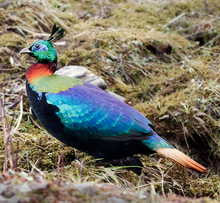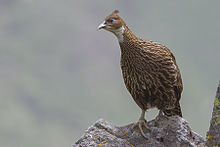Impeyan pheasant
| Himalayan monal | |
|---|---|
 |
|
| Male | |
 |
|
| Female | |
| Scientific classification | |
| Kingdom: | Animalia |
| Phylum: | Chordata |
| Class: | Aves |
| Order: | Galliformes |
| Family: | Phasianidae |
| Subfamily: | Phasianinae |
| Genus: | Lophophorus |
| Species: | L. impejanus |
| Binomial name | |
|
Lophophorus impejanus (Latham, 1790) |
|
The Himalayan monal (Lophophorus impejanus), also known as the Impeyan monal, Impeyan pheasant, is a bird in the pheasant family, Phasianidae. It is the national bird of Nepal, where it is known as the danphe, and state bird of Uttarakhand India, where it is known as the monal. It was also the state bird of Himachal Pradesh until 2007. Traditionally, the Himalayan monal has been classified as monophyletic. However, studies have shown that the male Himalayan monal of northwestern India lacks the white rump of other Himalayan monals, and it has more green on the breast, indicating the possibility of a second subspecies.
The scientific name commemorates Lady Mary Impey, the wife of the British chief justice of Bengal Sir Elijah Impey.
It is a relatively large-sized pheasant. The bird is about 70 centimetres long. The male weighs up to 2380 grams and the female 2150. The adult male has multicoloured plumage throughout, while the female, as in other pheasants, is dull in colour. Notable features in the male include a long, metallic green crest, coppery feathers on the back and neck, and a prominent white rump that is most visible when the bird is in flight. The tail feathers of the male are uniformly rufous, becoming darker towards the tips, whereas the lower tail coverts of females are white, barred with black and red. The female has a prominent white patch on the throat and a white strip on the tail. The first-year male and the juvenile resemble the female, but the first-year male is larger and the juvenile is less distinctly marked.
The bird's native range extends from Afghanistan through the Himalayas in Pakistan, Kashmir region, Nepal, southern Tibet, Bhutan and Indian states of Himachal Pradesh, Uttarakhand, Sikkim and Arunachal Pradesh. There is also a report of its occurrence in Burma. In Pakistan the bird is most common in the Khyber Pakhtunkhwa province but it can also be found in Kaghan, Palas Valley, and Azad Kashmir. It lives in upper temperate oak-conifer forests interspersed with open grassy slopes, cliffs and alpine meadows between 2400 and 4500 meters, where it is most common between 2700 and 3700 meters. It descends to 2,000 m (6,600 ft)2 in the winter. It tolerates snow and digs through it to obtain plant roots and invertebrate prey.
...
Wikipedia

